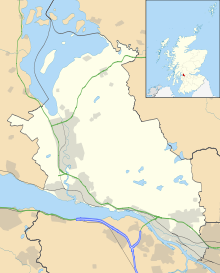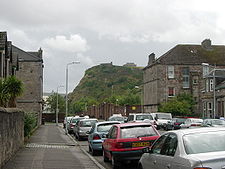- Dumbarton Castle
-
For warships of this name, see HMS Dumbarton Castle.
Dumbarton Castle Dumbarton, Scotland
GB grid reference NS399744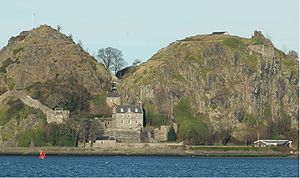
Looking across the River Clyde towards Dumbarton CastleLocation within West DunbartonshireCoordinates 55°56′10″N 4°33′46″W / 55.93611°N 4.56278°WCoordinates: 55°56′10″N 4°33′46″W / 55.93611°N 4.56278°W Dumbarton Castle (Scottish Gaelic: Dùn Breatainn, pronounced [d̪̊unˈb̊ɾʲɛhd̪̊ɪɲ]) has the longest recorded history of any stronghold in Great Britain. It overlooks the Scottish town of Dumbarton, and sits on a plug of volcanic basalt known as Dumbarton Rock which is 240 feet (73 m) high.[1]
Contents
History
Iron Age
At least as far back as the Iron Age, this has been the site of a strategically important settlement. Its early residents were known to have traded with the Romans. The presence of a settlement is first recorded in a letter Saint Patrick wrote to King Ceretic of Alt Clut (or Clyde Rock) in the late 5th century.
Dark Ages
From the fifth century until the ninth, the castle was the centre of the independent British Kingdom of Strathclyde. The King of the Britons of Dumbarton in about AD 570 was Riderch Hael, who features in Norse legends. During his reign Merlin was said to have stayed at Alt Clut. In 756 the first (and second) losses of Dumbarton Rock were recorded. A joint force of Picts and Northumbrians captured Alcluith after a siege, only to lose it again a few days later.
By 870 Dumbarton Rock was home to a tightly packed British settlement, which served as a fortress and as the capital of Alt Clut. The Vikings laid siege to Dumbarton for four months, eventually defeating the inhabitants when they cut off their water supply. The Norse king Olaf returned to the Viking city of Dublin in 871, with two hundred ships full of slaves and looted treasures. Olaf came to an agreement with Constantine I of Scotland, and Artgal of Alt Clut.
Strathclyde's independence may have come to an end with the death of Owen the Bald, when the dynasty of Kenneth mac Alpin began to rule the region.
Medieval Era
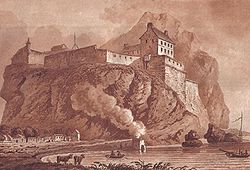 Dumbarton castle in 1800.[2]
Dumbarton castle in 1800.[2]
In medieval Scotland, Dumbarton (Dùn Breatainn, which means 'the fortress of the Britons') was an important royal castle. It sheltered David II and his young wife, Joan of The Tower after the Scottish defeat at Halidon Hill in 1333.
In 1425 the castle was attacked by James the Fat, youngest son of Murdoch Stewart, Duke of Albany, who had been imprisoned by King James I of Scotland on charges of treason. James the Fat became a rallying point for enemies of the King, and raised a large rebellion against the crown. He marched on the town of Dumbarton and burned it, but was unable to take the castle, whose defender John Colquhoun successfully held out against James' men. [3] [4]
Patrick Hepburn, 1st Earl of Bothwell, was Captain of Dumbarton castle on April 1, 1495.
Sixteenth century
During the war of the Rough Wooing, the castle was briefly occupied against the Scottish Government of Regent Arran by the Bishop of Caithness, Robert Stewart, a brother of Matthew Stewart, 4th Earl of Lennox, who came from England with the support of Henry VIII. He had sailed from Chester with around 20 followers in May 1546 in the Katherine Goodman and a pinnace.[5] Having borrowed the artillery of the Earl of Argyle, Arran successfully besieged the castle, which surrendered after 20 days. The chronicle historian John Lesley wrote that the Captain and the Bishop surrendered the castle to Arran and were rewarded, after negotiation by the Earl of Huntly.[6] The siege at Dumbarton delayed Arran's action at the siege of St Andrews Castle on the east coast of Scotland.[7]
In 1548, after the Battle of Pinkie, east of Edinburgh, the infant Mary, Queen of Scots was kept at the castle for several months before her removal to France for safety, where she was soon betrothed to the young dauphin Francis.
In October 1570, John Fleming, 5th Lord Fleming fortified the castle for Mary against the supporters of James VI of Scotland with stones he obtained by demolishing churches and houses in Dumbarton and Cardross.[8] His defence of Dumbarton for Mary was satirized in a ballad printed by Robert Lekprevik in May 1570; The tressoun of Dumbertane.[9] Attributed to Robert Sempill, the ballad describes Fleming's failed ambush of Sir William Drury.[10] The castle was captured by the forces of the Regent (Matthew Stewart, 4th Earl of Lennox) led by Thomas Crawford of Jordanhill in the early hours of 2nd April 1571, who used ladders to scale the rock and surprise the garrison.[11]
Seventeenth century
The castle's importance declined after Oliver Cromwell's death in 1658. Due to threats posed by Jacobites and the French in the eighteenth century, Britain built new structures and defences there and continued to garrison the castle until World War II.
The castle today
Today all visible traces of the Dark-Age Alcluith, literally Clyde Rock (Scottish Gaelic: Alt Chluaidh, pronounced [aɫ̪d̪̊ˈxɫ̪uəj]), its buildings and defences, have gone. Not much survives from the medieval castle: the 14th-century Portcullis Arch, the foundations of the Wallace Tower, and what may be the foundations of the White Tower. There is a 16th-century guard house, which includes a face which according to legend is "Fause Menteith", who betrayed William Wallace.
Most of the existing structures were built in the 18th century, including the Governor's House, built for John Kennedy, 8th Earl of Cassilis, and fortifications which demonstrated the struggle by military engineers to adapt an intractable site to contemporary defensive needs. The splendid views from the twin summits of the White Tower Crag and the Beak remind us why this rocky outcrop was chosen as 'the fortress of the Britons' centuries ago. [12]
The castle is open on a daily basis during the summer season and Saturday-Wednesday in the winter. Visitors must climb the 557 steps to see the White Tower Crag and other features.
Dumbarton Rock is in state ownership and is legally protected by the Scottish Government as a Scheduled Ancient Monument, to conserve it for future generations. Activities such as rock climbing are forbidden; any change or damage caused is considered a criminal offence.
References
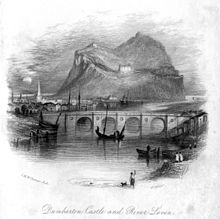 Dumbarton Castle, 1836 engraving by William Miller after J M W Turner
Dumbarton Castle, 1836 engraving by William Miller after J M W Turner
- ^ www.undiscoveredscotland.co.uk
- ^ Stoddart, John (1800), Remarks on Local Scenery and Manners in Scotland. Pub. Wiliam Miller, London. Facing P. 212.
- ^ McAndrew, Bruce A., p.5, Scotland's Historic Heraldry Retrieved November 2010
- ^ Campbell, Alastair, p. 113, A History of Clan Campbell, Volume 2 Retrieved November 2010
- ^ Dasent, ed., Acts of the Privy Council, 1542-1547, vol.1 (1890), 379
- ^ Thomson, Thomas, ed., John Lesley's History of Scotland, Bannatyne Club (1830), 190.
- ^ Accounts of the Lord High Treasurer of Scotland, vol. 8 (1908), lxxx, 453, 465: Letters & Papers Henry VIII, vol.21 part 2 (1910) no.6, Arran to the Pope.
- ^ Calendar State Papers Scotland, vol. 3, (1903), 383.
- ^ Calendar of State Papers Scotland, vol. 3, (1903), 177: The tressoun of Dumbarton, 15 May, Robert Lekprevik, Edinburgh, 1570.
- ^ Cranstoun, James, Satirical Poems of the Reformation, vol. 1 (1892) 170-173, & notes vol. 2 (1893), 113-7.
- ^ Lang, Andrew (1911). A History of Scotland. W. Blackwood in Edinburgh. pp. 64-68. http://www.archive.org/stream/shorthistoryofsc02languoft#page/64/mode/2up.
- ^ "Historic Scotland Official Souvenir Guide"
External links
Categories:- Historic Scotland properties
- Castles in West Dunbartonshire
- Category A listed buildings in Scotland
- Listed buildings in West Dunbartonshire
- Archaeological sites in West Dunbartonshire
- Listed castles in Scotland
- Wars of Scottish Independence
- Dumbarton
- Viking Age sites in Scotland
Wikimedia Foundation. 2010.

